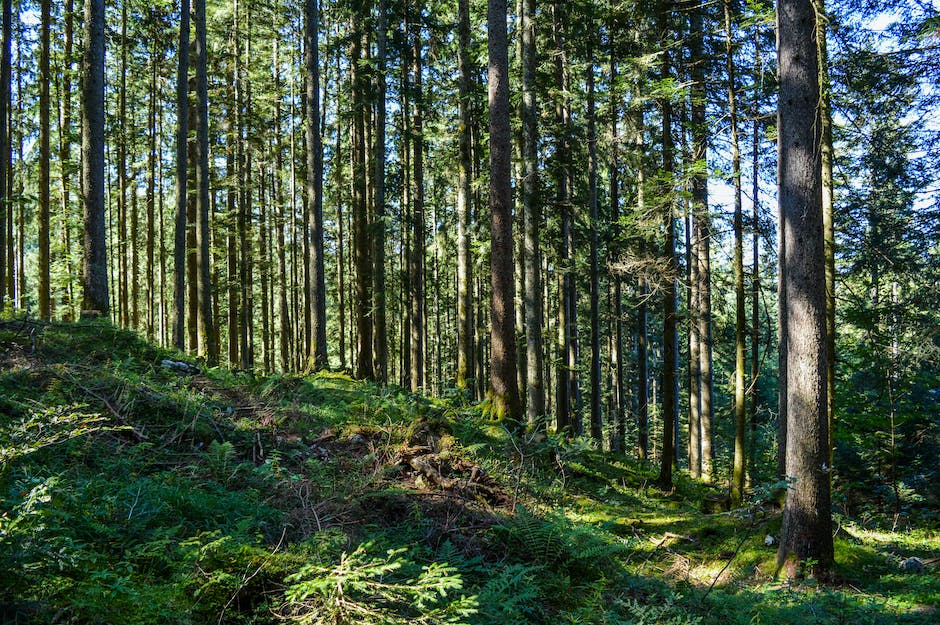There is no simple answer to this question as it depends on the species of squirrel. Some squirrels do live in pine trees, such as the American red squirrel, but others, like the gray squirrel, live in many different types of trees. In general, though, squirrels tend to prefer areas with a mix of trees rather than just one type.
That is a difficult question to answer definitively because there are so many types of squirrels and pine trees! Generally speaking, however, most squirrels do not live in pine trees specifically. Some types of squirrels that might live in or near pine trees include the American red squirrel and the American black squirrel.
Do GREY squirrels nest in pine trees?
Gray squirrels are interesting creatures in that both male and female gray squirrels of all ages participate in building dens. They typically build leaf nests in the summer by weaving together small branches they’ve gnawed off of trees. These nests are lined with grass, moss, leaves and pine needles. It’s fascinating to watch them build their homes and it’s also interesting to note that they seem to take great pride in their handiwork.
Pine cones are a great food for squirrels, and they are healthy and natural for them to eat.
What does a squirrel nest look like in a pine tree
Squirrels are small, rodent-like creatures that are known for their bushy tails and their love of nuts. They are also known for their dreys, which are small, round nests made of leaves and twigs. Squirrels usually build their dreys into tree cavities or around tree branches that are 20 feet high or higher. Dreys can vary in size, but they’re usually around six to eight inches in diameter.
Pine cones are an important source of nutrition for squirrels during the winter months. The cones contain various nutrients, including proteins, carbohydrates, and fats. These nutrients can help squirrels survive the cold months when food is scarce.
How do I keep squirrels out of my pine tree?
If you have a problem with ground squirrels getting into your yard and eating your plants, you can use squirrel baffles to keep them away. Squirrel baffles are metal collars that you put around trees, at least six to eight feet off the ground. You can also use them on poles that support your bird feeders.
The red squirrel will then nibble at the seeds, eating some and storing others in a special cheek pouch to take back to its nest. By the end of the season, a red squirrel may have collected and stored as many as 4,000 seeds.”
A red squirrel will frequent the base of a particular pine tree to eat, chewing scales off the core of a cone the way people eat corn-on-the-cob. First it chews the scales off near the stem. As each scale falls away, a pair of seeds is exposed.
The red squirrel will then nibble at the seeds, eating some and storing others in a special cheek pouch to take back to its nest. By the end of the season, a red squirrel may have collected and stored as many as 4,000 seeds.
What trees attract squirrels?
If you want to attract squirrels to your garden, choose trees that produce nuts and have hollows that they can nest in. Good trees for this include willows, aspens, spruces, and pine trees.
As a gardener, you should aim to plant trees that provide food and shelter for squirrels. By doing so, you can help populations of these animals thrive in your area. The following are seven of the best trees to plant to attract squirrels to your garden:
1. Persimmon (Diospyros virginiana)
2. Pignut Hickory (Carya glabra)
3. Red Maples (Acer rubrum)
4. Southern Magnolia (Magnolia grandiflora)
5. American Beech (Fagus grandifolia)
6. White Oaks (Quercus alba)
7. Chestnut Oaks (Quercus castanea)
Do squirrels pile up pine cones
Squirrels are known for their knack for gathering and storing food for the winter months. One of the things they like to store are cones from pine trees. The cones are unopened and still full of seeds. By burying the cones in a pile of debris, the squirrels are able to keep them cool and moist. This prevents the cones from opening and losing their seeds. The cones can stay in this state indefinitely, as long as they stay cool and moist.
Pine needles and the inner bark of twigs are important food sources for Abert’s squirrels. They help the squirrels to survive in the winter when other food sources are scarce. I find it fascinating that these squirrels are able to find and eat these things.
Do squirrels sleep inside trees?
Compared to gray squirrels, ground squirrels have very different winter habits. While gray squirrels will sleep in tree nests and only come out during the morning and evening, ground squirrels live on or in the ground and do not hibernate. Instead, they rely on sheltered nests or dens, fat reserves, and stored food to survive the long, cold winter.
is essential for squirrels to stay nice and toasty in the winter Nests are often built out of twigs, leaves, and moss in tall trees, although a squirrel won’t turn down your home’s attic to build its nest.
Do squirrels eat pine branches
The type of squirrels that commonly live in trees are referred to as tree squirrels. These include species such as the eastern grey squirrel, fox squirrel, and pine squirrel. While they generally eat a diet of nuts, seeds, and fruits, tree squirrels may also eat pine cones and nip twigs. This can interfere with the natural reseeding of important forest trees, particularly in Ponderosa pine forests. In poor to fair seed years, tree squirrels can remove up to 60% to 80% of the cones, which can jeopardize the regeneration of the forest.
To prevent tree damage from beavers, you can install a wire mesh around the tree trunk. The mesh should extend a few feet above the ground and a few feet below the waterline. You can also attach a heavy wire to the tree trunk and extend it a few feet above the ground to make it harder for the beavers to climb. To keep beavers from raiding your bird feeders, you can keep the feeders close to the house or put them on a high platform.
Do squirrels help or hurt trees?
Squirrels, voles, rabbits, and porcupines can all be major tree pests. They cause serious wounds by feeding on tree fruit, nuts, roots, bark, leaves, and twigs. This can damage and kill trees. If you have any of these animals in your yard, it’s important to take measures to keep them away from your trees.
If you’re looking for a natural way to keep squirrels away from your plants and flowers, try using a mixture of water and pepper or peppermint oil. The strong scent of these spices will deter squirrels from coming near, while also causing them to sneeze and cough if they do get close.
What scares squirrels away
There are many different ways that you can deter squirrels from your yard or garden. Some people use rodent-chasing dogs, while others use motion-activated noisemakers, such as garden spinners, pinwheels, and aluminum pie tins. You can also use a motion-detecting sprinkler to increase the scare factor.
It is clear that for the pine tree, producing a large number of pinecones is a matter of survival. By producing a large number of pinecones, the tree is able to ensure that at least some of its seeds will survive to germinate and produce new trees. Additionally, the production of a large number of pinecones may also be a way for the tree to protect itself from insect infestations.
Do squirrels live in evergreen trees
The red squirrel is a small, adept tree-climbing squirrel that is common throughout the boreal forest of North America. It is also found in the mountains of the western United States, as well as in some parts of southern Canada. The red squirrel prefers a mixed hardwood-conifer forest type. Evergreen trees such as spruce, hemlock, pine, or fir are almost always present within its range. The red squirrel has reddish-brown fur on its back and creamy white fur on its underside. It is smaller than the grey squirrel, and its ears are smaller and less rounded. The red squirrel is an important part of the forest ecosystem, as it is a keystone species in the dispersal of tree seeds.
Squirrels play an important role in shaping plant composition in forest ecosystems. They accomplish this by their habit of taking seeds and burying them. This provides nutrients for the plants and helps them to grow and flourish.
What trees repel squirrels
Galanthus plants are effective at deterring pests like squirrels due to their strong smell. Bulbous plants like these release a scent that many animals find unpleasant, making them an ideal natural barrier for keeping unwanted wildlife out of your garden.
If you have a bird feeder, nut or fruit tree and vegetable garden, you’ve probably already attracted squirrels to your property. Squirrels commonly eat nuts, acorns, birdseed, insects, fungi, fruit and vegetables, so you may see them around your property more often. While they can be pesky, try to enjoy their company and the wildlife they bring to your yard!
What is the most common predator of squirrels
Eastern gray squirrels have many predators. Minks, weasels, bobcats, raptors, red foxes, and other predatory animals prey on them. The squirrels will emit a warning call to let other squirrels know predators are near. They are hard to capture because they can climb and jump among trees quickly and easily.
It is interesting to note that grey squirrels are largely animals of deciduous woodland. This is because they are dependant upon the large seeds of such trees as oak, beech, hazel, sweet chestnut and walnut.
Final Words
Yes, squirrels often live in pine trees.
Yes, squirrels live in pine trees. Squirrels are a type of rodent, and rodents are known to live in trees. Pine trees provide a good environment for squirrels because they have a lot of leaves and needles, which provide shelter and camouflage.
Mark Hoffman is a dedicated arborist and tree care specialist with over a decade of experience. His love for trees began when he visited Yosemite National Park as a teenager and was awestruck by the giant sequoias. Mark pursued his passion by studying forestry at Michigan Technological University, where he earned a Bachelor of Science degree.
Since then, he has worked tirelessly in the field of arboriculture, helping to preserve and protect trees in his community. His expertise and dedication have made him a respected leader in the industry and a valuable resource for anyone seeking advice on tree care.
